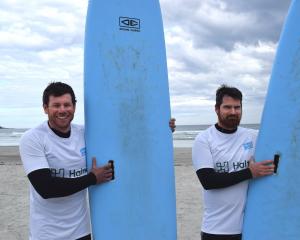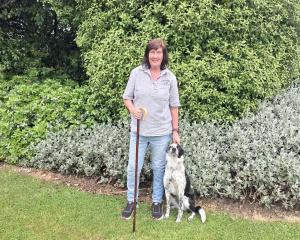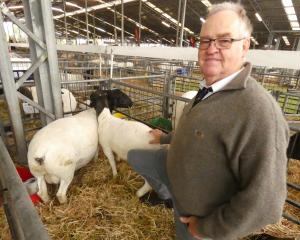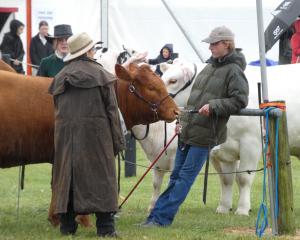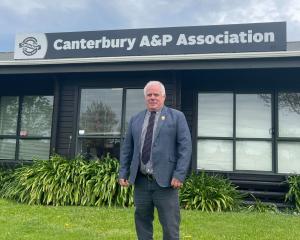
Welsh expat Graham Evans first visited New Zealand on his post-university OE and got farm work in the South.
Years later, he was home working on a sheep and beef farm in Wales when a southern dairy farmer called to offer him a job milking cows.
He accepted and he and his wife Sue and then 5-year-old son Rhys entered the New Zealand dairy industry, their progression including sharemilking on the Taieri for four years.
Despite a lack of equity, the money coming into the business allowed them to make improvements to their farm business.
"Our cashflow was phenomenal," Graham recalled.
The family sold 520 dairy cows and about 200 heifers to buy sheep and beef property Barr Falls Farm in Owaka in 2001 at a time when farms were much cheaper. The cost was about $330 per stock unit and they were lucky to get in when they did, he said.
When Rhys moved home about seven years ago, they bought a 40ha neighbouring block which cost about $1300 per stock unit.
The aim was to keep cashflow coming in by having something to sell every month so the overdraft did not build up too much.
The farm operation included mating their heifers once, to a Te Mania Angus bull, to calve in mid-September.
Steers were wintered and sold in November or December, a time when big farm expenses needed to be paid, Rhys said.
"These guys are a pretty good money earner for us," he said.
The cost of wintering steers on beet and ryegrass was worth it due to the higher kill price when the steers were sent away, weighing about 400kg, so it was a "no-brainer" for the family.
The steer kill prices had ranged between $1200 and $1600 in December, much higher than now when everyone was trying to kill cattle and the price had bottomed out.

Lambs were also wintered on farm. If the lambs were sold now, they would fetch about $75 each.
To improve the margin, about 200 lambs were wintered on a swede crop, which cost $1000/ha to grow, and culled in September, fetching about $140 each.
Weaning animals early had never been an option on Barr Falls because of cold conditions stunting grass growth so an early schedule price could never be met.
A way to create extra cashflow was lambing hoggets and about 400 hoggets, usually 40kg or heavier, were mated.
The hoggets lambed in late October and their progeny were sent away in September or October the following year.

He was unsure if chasing a constant cashflow was good business practice or not.
"I don’t know if it is right or wrong — it is just how my brain works — I don’t like giving the bank money," Graham said.
Rhys said they had taken on debt to buy neighbouring blocks of farmland.
As the price of land was high and commodity prices were low, it was important new blocks could handle being pushed and responded to fertiliser and grow young grass so they could be productive and progress the business.
"We are not afraid to spend money to make money," Rhys said.
If land was unproductive it could become a burden as interest on a debt accrues.
"That’s the mindset we have with everything on the farm — it has to be making us money."
They bought a north-facing neighbouring property which included "pretty buggered" pine forestry.
Forestry had soured the ground and sucked moisture from it.
The trees were felled and, around the stumps, kale seed was sown and 10 tonne of lime per hectare was applied by air.
Since the trees had been removed many springs had started running again.
Brassicas were grown in the paddock for two years, followed by red clover and plantain for three years.
When the stumps were easier to remove, they began sowing short-term grasses.
Those paddocks were now the most productive on the farm.
"This is probably the best country you’ll see on our farm."
The farm had its own direct drill which he quipped was "held together with hopes and prayers and a bit of duct tape and a few zip ties but it does an outstanding job".
Contractors were once used to direct drill seed in the past.
"They always went too quick and too shallow because they were scared of the rocks and the crops just weren’t there."
They bought their own direct drill and put heavier tines on and did seeding at a slower pace.
"We get pretty good crops out of it — relatively cheaply because we do it ourselves."

Since the farm was between 280m to 330m above sea level and exposed, creating more shelter for their lambs was their next priority, Rhys said.
"When it is cold, it is really cold."
He bought Romney rams from the North Island this season to introduce new genetics to their mostly Coopdale flock.
The hope was the Romney genetics would stabilise the performance of the flock, including the size of the ewe lambs and produce fewer triplets, as multiples were a "nightmare".
Their terminal sire breed was transitioning from Lamb Supreme to Suftex.
"We love the Lamb Supremes, we found they had really good vigour, they’d hit the ground and be up."
The move away from Lamb Supremes was due to its white face.
A black face Suftex would make management easier.
To reduce costs, they both did shearing and crutching of their flock.
Fertiliser was an input Graham would never skimp on and he applied more of it when cash was available in the business.
"Tax or fertiliser? It’s a no-brainer for me," he said.
Rhys said the flexible system on Barr Falls Farm allowed them to sell a lot of animals without having to carry a lot of them.
The $30,000 to $40,000 made from sending steers away was welcome when bills were coming in at the end of the year and stopped them going into overdraft.
Another pleasing part of the operation was bucking a trend by transforming forestry blocks to pasture. "I get a lot of satisfaction out of that," he said.


